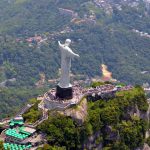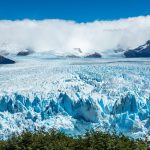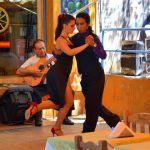Cruise Specialists hosts Steve and Wendy Bodenheimer are taking us along on another amazing journey. We hope this series shows you what you can expect on a Holland America Grand Voyage. First was the kick off, then Costa Rica, the Panama Canal, Chile, Patagonia, Antarctica, Argentina, Brazil and now the next stop in their Grand South America & Antarctica Voyage (next voyage January 2018).
Santarem
Our first stop on this amazing body of water is the small city of Santarem. It doesn’t look like a place with 300,000 people, but they are here, as well as thousands who come to visit or to shop.
This is a center of commerce on the lower Amazon, usually crowded with riverboats bringing people from other villages and towns to buy everything from bananas to big screen televisions.
So what does a visitor do here? The hot ticket for excursions was piraña fishing. Almost a hundred people boarded three boats to try their luck at catching one of these feared and mysterious fish.
We heard that only 3 were caught but it was a good time. They were also able to see the “meeting of the waters”, a fascinating phenomenon unique to this area.
The Amazon merges with the Tapajos River and for miles they flow side by side without the waters mixing. The blue green Tapajos can clearly be seen beside the sandy brown Amazon as if there were some physical barrier between them! It’s quite a sight. 
The downtown of Santarem has a pleasant promenade where visitors can watch the activity on the bustling waterfront, visit the Cathedral, the fish market, or the Joao Fona Museum housed in a waterfront mansion. You can also venture out of town to the Tapajos National Forest – a million acres of rainforest reserve.
River Villages
On to the tiny village of Boca de Valeria. This is the kind of place guests either love or hate.
A very short tender ride brings us to a primitive spot that is home to probably less than 100 people. But when the ships come in, locals from the villages all up and down the river come by boat to greet the passengers and make some money.
Dozens of children bring their pet monkeys, parrots, sloths, toucans, and lizards and collect a dollar for every picture taken. Some are dressed in native costumes, some just want to escort you around the village and collect several dollars for their time. Guests are invited into the houses and the school or they can purchase primitive crafts and jewelry items available for sale. Boat rides are offered for $5.00 per 30 minutes. 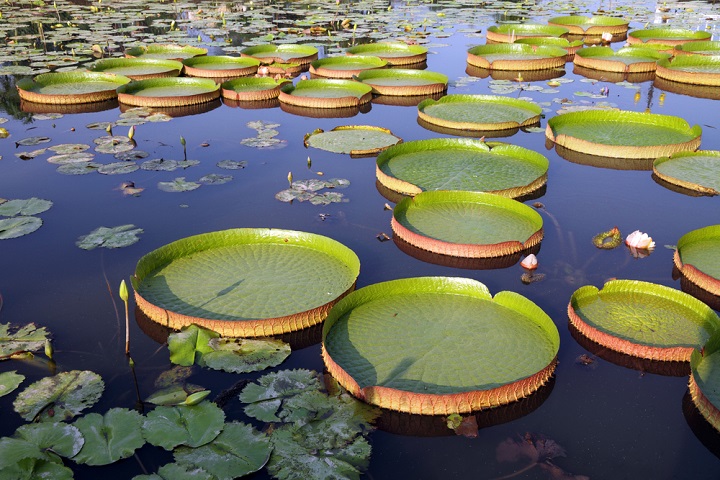
We took one of the boats and wound up with a 1.5 hour tour that included a ride on the open river, a detour through some real murky jungle water, a delightful stop among the 4-foot in diameter lily pads, and a visit to the real village a few miles up river.
We had been there before and were amazed at the combination of high tech possessions with primitive living conditions. Satellite dishes are everywhere and all the young people have cell phones. Our driver took us to his house to meet his father, wife, baby, and at least one of his 4 sisters. He also has 6 brothers and all the children live in the village.
Two large motor bikes were parked inside the doorway of the house – we wondered where they go with them? But we were communicating mostly with sign language, so we couldn’t ask too many questions.
We also wondered what they do with all the American dollars that are collected in a given day – totaling many hundreds. Does someone take them all to a bank to convert them? Do they pool the resources? We understand that Holland America donates lots of used and excess items from the ship and that many guests had brought school supplies for donation.

We had an interesting day and felt good about the money we left with Carlos and his family. But we understand why some guests object to the “fake village” and the use of the children to collect money.
Back on the ship, we had a wonderful show from the outside decks put on by the local pink dolphins. Yes, they really are pink and they are only found in this part of the Amazon. Several were playing in the bay between the ship and shore and came quite near so we could see them up close. A real treat.
Manaus
From tiny Boca de Valeria to Manaus, city of 1.6 million. We are 900 miles up the Amazon and as far as we will go.
In the late 19th century, the Brazilian Amazon had a period of amazing prosperity as the only rubber supplier in the world. During this “rubber boom”, great wealth resulted in some stunning buildings that have survived and been preserved such as Teatro Amazonas, also known as the Opera House and the Mercado Municipal Adolfo Lisboa, a massive cast iron market selling a vast array of merchandise.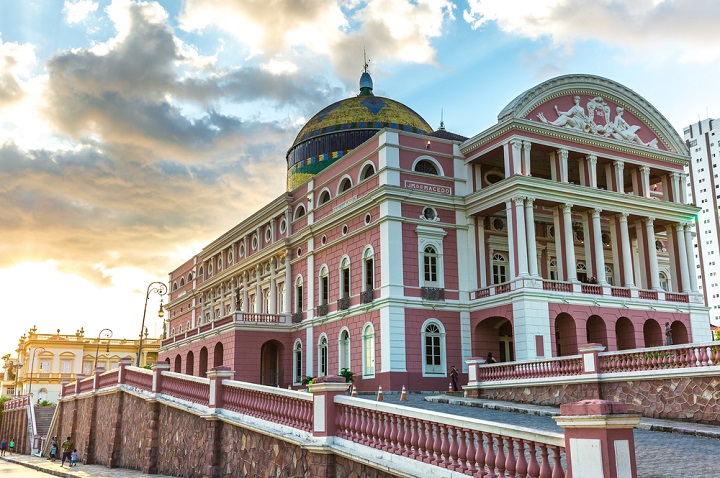
These two places are the most popular for visitors, conveniently located within walking distance of the port. But there are other options:
- You could take a riverboat up to Lake January and then continue in 10-person canoes to get a closer look at the “meeting of the waters”. Here, it’s the very dark Rio Negro meeting with the light and sandy colored Rio Solimoes.
- You could also try a jungle trek with a native guide or a visit to an indigenous village to see the shaman perform tribal rituals.
- Or for the really adventurous, there is an overnight in the jungle at the Amazon Ecopark Jungle Lodge.
- Explore the famous market with sections devoted to meat, spices and medicinal herbs, souvenirs, fish, jewelry, cheeses, grains and of course, a food court with prepared meals and snacks.
On our evening in port, a local dance troupe presented a history of dance in Brazil through the ages – from primitive tribal rituals through today’s Carnival. It was energetic, colorful, and loud. We recognized a few of the performers from previous years.
Learn about next Grand South America and Antarctica Voyage >>
Cruise consultant Joe Lucero can help answer your questions about cruising Antarctica or a Grand Voyage!
